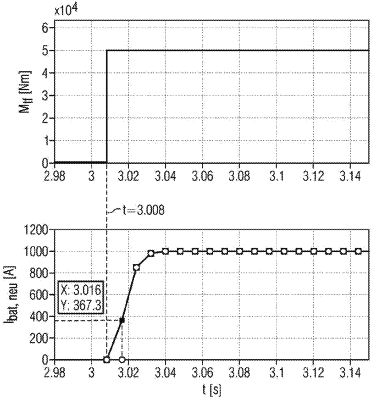| CPC H02J 7/00714 (2020.01) [H02J 7/0063 (2013.01); H02J 7/345 (2013.01); H02P 23/30 (2016.02); B60L 15/20 (2013.01); B60L 50/51 (2019.02); B60L 50/60 (2019.02); B60L 2200/26 (2013.01); B60L 2210/40 (2013.01); B61C 3/00 (2013.01); H02J 2207/20 (2020.01); H02J 2310/48 (2020.01); H02P 2207/01 (2013.01)] | 6 Claims |

|
1. A method for controlling a current output of a battery, wherein the battery is used as a traction battery for driving a rail vehicle, which comprises the steps of:
passing an actual battery current lbat,ist, as a link circuit direct current, to a link circuit via a rectifier;
applying an actual differential voltage Ud,ist to the link circuit;
passing the link circuit direct current Idcdc, as a motor current Imot, from the link circuit to a DC/AC converter, which converts the motor current Imot to a three-phase alternating current;
feeding the three-phase alternating current to an asynchronous motor, which is used as a drive of the rail vehicle;
controlling the asynchronous motor and the DC/AC converter via a torque controller;
using the torque controller to control a setpoint torque value Msoll, by way of which the motor current Imot is set;
using a link circuit voltage controller to determine a setpoint battery current lbat,soll based on a setpoint differential voltage Ud,soll and based on an the actual differential voltage Ud,ist, the link circuit direct current lac& being set based on the setpoint battery current;
controlling the DC/DC converter by means of a battery current controller, which sets the link circuit direct current lac& based on the setpoint battery current lbat,soll and based on the actual battery current lbat,ist;
forming the setpoint torque value Msoll from a feedforward control torque Mff and from a specified torque Mtf taking into account a relationship of Mtf>max (Mff);
forming the feedforward control torque Mff based on the actual battery current lbat,ist until the actual battery current lbat,ist corresponds to an ideal battery current lbat,ideal;
calculating the feedforward control torque Mff using a transfer function Hsys(Z), which maps the setpoint torque value Msoll onto the actual battery current lbat,ist as follows:
lbat(Z)=Hsys(Z)Msoll(Z),
determining a zero point z=znmp, which lies outside of a unit circle, by the transfer function Hsys(z); and
calculating the feedforward control torque Mff as follows:
Mff(Z)=lbat,neu(Z)/(Hsys(Z)Z)
with:
lbat,neu(z)=lbat,ideal(Z)−lbat,ideal(Z=Znnmp)
and with:
lbat,neu[n]=lbat,ideal[n] for all n>0,
such that a pole point/zero point cancelation is achieved by z=znmp at the ideal battery current lbat,ideal.
|